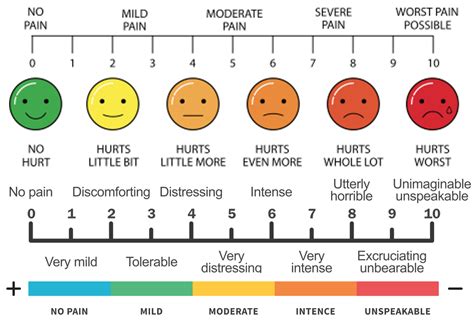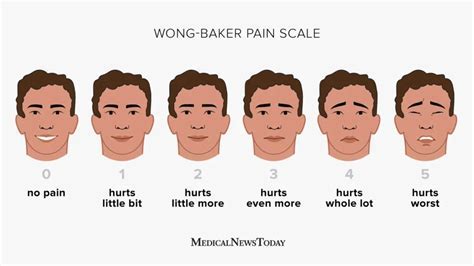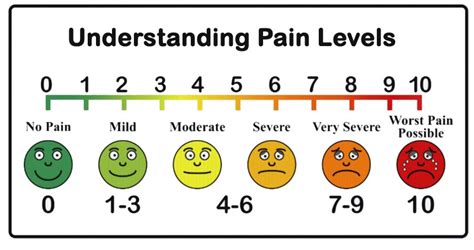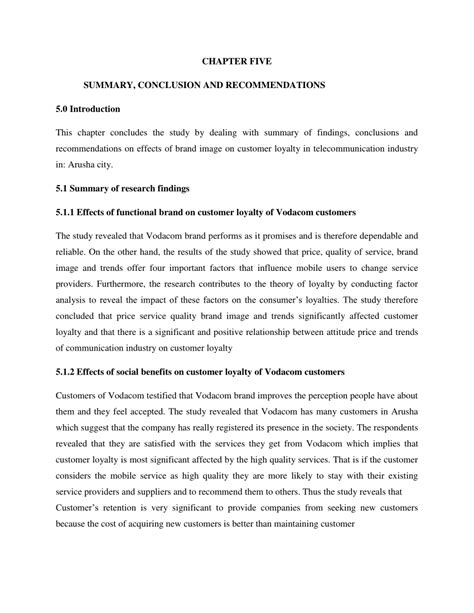Intro
Understand pain intensity with our Pain Level Scale Guide, featuring pain assessment tools, pain management strategies, and chronic pain relief techniques to help measure and manage acute and neuropathic pain effectively.
Pain is a universal human experience that can significantly impact an individual's quality of life. The perception of pain varies greatly from person to person, making it challenging to quantify and manage. To address this issue, healthcare professionals use various pain assessment tools, including the pain level scale. This scale provides a standardized method for evaluating the severity of pain, enabling healthcare providers to develop effective treatment plans. Understanding the pain level scale is essential for both healthcare professionals and individuals experiencing pain, as it facilitates communication and ensures that pain is adequately addressed.
The pain level scale is a vital component of pain management, allowing individuals to convey the intensity of their pain to healthcare providers. This information is crucial in determining the most suitable treatment approach, as it helps healthcare professionals to identify the underlying cause of pain and develop a personalized treatment plan. Moreover, the pain level scale enables individuals to track changes in their pain levels over time, making it easier to adjust treatment strategies as needed. By using the pain level scale, individuals can take an active role in managing their pain, which can lead to improved health outcomes and enhanced overall well-being.
The importance of the pain level scale extends beyond the individual, as it also has significant implications for healthcare systems and society as a whole. Effective pain management can reduce healthcare costs, decrease the risk of complications, and improve patient satisfaction. Furthermore, the pain level scale can help to reduce disparities in pain management, ensuring that all individuals receive equitable care regardless of their background or socioeconomic status. As research continues to advance our understanding of pain and its complexities, the pain level scale remains a fundamental tool in the quest to provide optimal pain care.
Introduction to the Pain Level Scale

Components of the Pain Level Scale
The pain level scale consists of several key components, including: * A numerical rating system (0-10) * A verbal descriptor scale (e.g., mild, moderate, severe) * A faces scale (e.g., smiling face, neutral face, frowning face) These components work together to provide a comprehensive assessment of pain intensity, enabling healthcare professionals to develop targeted treatment plans.Types of Pain Scales

Benefits of Using Pain Scales
The use of pain scales offers several benefits, including: * Improved communication between healthcare providers and patients * Enhanced accuracy in pain assessment * Increased patient satisfaction with pain management * Better outcomes and reduced healthcare costsPain Level Scale Applications

Challenges and Limitations of the Pain Level Scale
While the pain level scale is a valuable tool in pain management, it also has several challenges and limitations, including: * Subjectivity: pain is a subjective experience, making it difficult to quantify and compare * Cultural and linguistic barriers: the pain level scale may not be effective in patients with limited English proficiency or cultural differences in pain expression * Cognitive impairment: patients with cognitive impairment may have difficulty using the pain level scaleFuture Directions in Pain Level Scale Research

Implications for Clinical Practice
The pain level scale has significant implications for clinical practice, including: * Improved pain assessment and management * Enhanced patient satisfaction and outcomes * Reduced healthcare costs and complicationsConclusion and Recommendations

Final Thoughts
The pain level scale is a simple yet powerful tool in pain management, enabling healthcare professionals to develop targeted treatment plans and improve patient outcomes. By understanding the components, applications, and limitations of the pain level scale, healthcare professionals can provide optimal pain care and enhance the quality of life for individuals experiencing pain.What is the pain level scale?
+The pain level scale is a numerical rating system that ranges from 0 to 10, with 0 indicating no pain and 10 representing the worst possible pain.
How is the pain level scale used in clinical practice?
+The pain level scale is used to assess pain intensity, develop targeted treatment plans, and monitor changes in pain intensity over time.
What are the limitations of the pain level scale?
+The pain level scale has several limitations, including subjectivity, cultural and linguistic barriers, and cognitive impairment.
Can the pain level scale be used in diverse populations?
+Yes, the pain level scale can be used in diverse populations, including pediatric and geriatric patients, although modifications may be necessary to address specific needs and limitations.
How can healthcare professionals use the pain level scale to improve patient outcomes?
+Healthcare professionals can use the pain level scale to develop targeted treatment plans, monitor changes in pain intensity, and adjust treatment strategies as needed to improve patient outcomes and enhance the quality of life.
